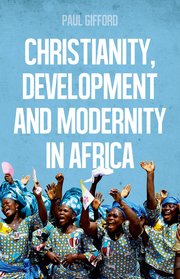|
Reviewed by Nathan P. Devir, Ph.D., Assistant Professor of Jewish Studies, Religious Studies, and Comparative Literary and Cultural Studies, Director, Middle East Center/Middle East Studies Program, University of Utah After decades spent researching a wide range of African religious movements, Paul Gifford is uniquely positioned to offer a salient meta-level analysis of not only the types of religion currently practiced on the continent, but also of the ways in which academics have tended to discuss and dissect them. His recent volume titled Christianity, Development and Modernity in Africa, which draws on lessons and experiences from throughout his distinguished career, provides a critical lens on both aspects of the aforementioned themes related to varied religious phenomena in Africa. It also offers several new denominational and country-specific case studies that help to shed light on the spiritual dynamism of African Christian cohorts heretofore unexplored. At the core of this succinct but highly informative book is Gifford’s aim to theoretically tackle a subject that has (as he rightly claims) been “studiously avoided” in the scholarly literature due to fears of Eurocentric essentialism: the pervasive African preoccupation with witchcraft, demonology, and the spirit world, which he terms “the enchanted religious imagination” (1). This fixation on otherworldly realms and their influence in daily life, according to Gifford, is the key to understanding the fundamental principles at work in the domains of religious belonging and practice in Africa. In other words, internalizing this realization of what ultimately makes African believers tick gives scholars a useful framework for unpacking diverse manifestations of the sacred, including but not limited to the realms of (institutionalized) Christianity. In that vein, qualifiers such as “Protestant,” “Catholic,” “evangelical,” or “Pentecostal” are, for Gifford, not helpful in formulating correct categorizations of faith-based expression and belonging, as they tend (to use his specific example of Catholic theology) to “ignore the religious imagination of so many” (144) Africans who profess any one particular affiliation. To ameliorate our approaches to such topics, Gifford attempts instead to delineate another method of explaining the essence of how Africans choose and relate to their religious adherence. This method, which rests more on weighing contextual factors than doctrinal ones, privileges what he advocates as an analysis foregrounded in “something local and cultural” (5) rather than on blanket descriptions based on externally-imposed denominational criteria. Employing this method, he showcases the raisons d’être behind popular religious movements such as Daniel Kolawole Olukoya’s Mountain of Fire and Miracles Ministries and David O. Oyedepo’s Living Faith Church Worldwide, both based in Nigeria. He subsequently does this as well in the superbly crafted section on “enchanted Catholicism,” which examines important features of the Catholic charismatic movement in differing African locales. In this reviewer’s estimation, the only portions of the study that could have been buttressed with additional examples are those concerned with the relationship between Christianity and development, in particular because the title suggests that this relationship is one of the book’s main themes. Gifford does indeed, at several junctures, discuss significant topics related to development and religious institutional belonging, especially regarding the Catholic Church, which he astutely labels the “biggest single development agency on the continent” (151). However, these sections of the book, while insightful, feel somewhat incomplete. On the whole, Gifford has made a major contribution in this volume to expanding our notions of how the subject of “enchantment” and its correlation to denominational belonging should be treated in contextual studies of African religion. Even more than that, Gifford’s opposition to “the [simplistic] presumption that religion is religion, whether one is talking about Ghana or Sweden” (165) is instructive for further studies on non-Christian African religious movements, be it Islamic, Jewish, Hindu, “traditional” (i.e., animistic) etc., in that it places the emphasis squarely on analyzing religious phenomena from within rather than from without—an approach that, as he so masterfully demonstrates, is woefully absent in the scholarly literature of this and other related fields. |


 Christianity, Development and Modernity in Africa
Christianity, Development and Modernity in Africa 